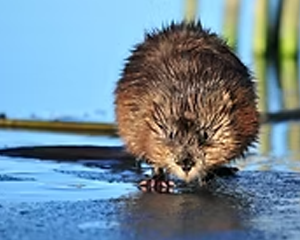Muskrat - Commonly Trapped Furbearer
UTILIZING OUR ABUNDANT MISSOURI WILDLIFE

Muskrat
Fast Facts
- Classification: Rodent
- Incisor Teeth: 4 (two upper, two lower)
- Length: ~22-25 inches (including tail)
- Weight: 2-4 pounds (varies by region)
- Litter Frequency: Up to 5 litters per year
- Litter Size: ~5 kits per litter
- Breath-hold ability: Up to 10-12 minutes underwater
- Life Span: Less than 4 years
The muskrat is a common and valuable furbearer. Muskrats are widely distributed throughout North America. This species can adapt to a variety of climates. Muskrats are dependent upon water. This species thrives in many lakes, rivers, creeks, ponds, and marshes. Muskrats can tolerate a certain amount of pollution in water, and this important furbearer is often found living within large cities.
Description
The muskrat is classified as a rodent because of its four incisor teeth in the front of the mouth. The two upper and two lower incisors overlap, allowing them to self-sharpen as they are used. Folds of skin behind the incisors allow a submerged muskrat to cut vegetation without getting water into its mouth. The size and weight of muskrats varies by region and the quality of food available. Southern muskrats average around 2 pounds in weight, and weights of 3 and 4 pounds are common for muskrats in northern states. Most adult muskrats attain a length of 22-25 inches, including the nearly hairless tail.
The muskrat has relatively small front feet, with four major toes and small thumbs. Hind feet are much larger and partially webbed. The tail of a muskrat is deeper than it is wide, and it tapers to a blunt point at the end. The species uses its tail as an aid for swimming.
Muskrat fur is short and dense. Colors are mostly browns with lighter shades of grays or blonds on the chest and stomach. The underfur traps air and prevents the skin of the muskrat from becoming wet while it is in the water. Musk glands are predominant beneath the skin on the lower abdomen of male muskrats. These two glands become swollen during the spring and produce a yellowish, musky-smelling fluid.
Reproduction
Muskrats are one of our most prolific species. Adult muskrats can have up to five litters in a year’s time. Muskrats in northern states seem to average about 2.5 litters per year. Muskrats in southern states often average three litters. Litter sizes vary, and five or six kits per litter is common. There is evidence that muskrat populations may be somewhat cyclic. Muskrats produce fewer litters when populations are dense and more litters when populations are sparse. The quality and abundance of food also affect the number of litters and litter sizes.
Female muskrats born in the spring are sometimes capable of raising their own litters by late summer or early autumn. An average female muskrat will raise about 15 or 16 young in a good year. One female muskrat has been known to produce 46 young in one year. The gestation period for muskrats is 29 days. Muskrats are thought to have one mate during rearing seasons. Populations can be estimated in the fall by counting lodges and multiplying by five.
Habits
Muskrats are somewhat sociable with others of the same species but will often fight to the death as populations become dense. Preferred foods include a variety of vegetation, including roots, stems, and buds. Muskrats often seek out undercut banks for protection while feeding. Food is usually carried by this furbearer by mouth, and eating takes place above the water level. Muskrats are often active during the day, as well as night, with peak activities near dawn and dusk.
Range
Muskrats are widely distributed throughout North America. Forty-eight states have muskrat trapping season.
General
Uncontrolled muskrat populations do cause damage to private property and habitats. Hole-digging activities undermine earthen dams and dikes. Damages also occur to irrigation canals and farm ponds. Large populations of muskrats also cause “eat-outs.” These areas are simply over-cropped by the feeding activities of the muskrats and the loss of vegetation, and resulting silting makes the area less productive for other wildlife. Muskrat eat-outs often destroy the roots of the vegetation, and it may take 15-20 years for the habitat to return to its original capacity to serve wildlife.
Muskrats are an important prey for a variety of wildlife, including mink, fox, coyotes, hawks, and owls.
One major disease is Errington’s disease. This serious virus can live in mud and infect muskrats in areas that have been uninhabited by other muskrats for as long as five years. Epidemics can and do occur with this devastating disease. Muskrats are also vulnerable to tularemia and a variety of internal and external parasites.
Few muskrats reach 4 years of age.
Contact Missouri Trappers Association
Get in touch with the Missouri Trappers Association by filling out the contact form. We appreciate your support!
For questions regarding your membership, please call
Joslyn Search: (660)292-1911


